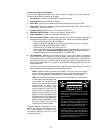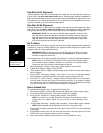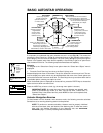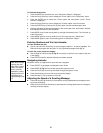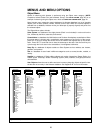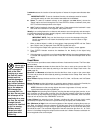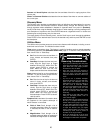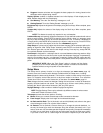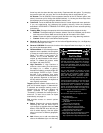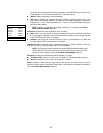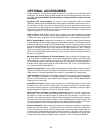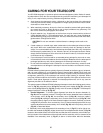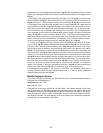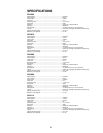
27
Arrow key and also slews the tube more slowly. Experiment with this option. Try changing
the percent value until you get a "feel" for the Arrow keys that is comfortable for you.
Alt Percent: The Alt (Altitude) Percent operates identical to the AZ Percent option (see
above), but allows you to change the altitude backlash, i.e., the way the Arrow keys move
the telescope when moving along the altitude (vertical) axis.
■ Train Drive: Trains the Altitude and Azimuth motors to locate objects with more precision.
If you are experiencing any problems with pointing accuracy, follow the procedure
described in “APPENDIX D: TRAINING THE DRIVE,” page 38, to insure accurate pointing
and tracking.
■ Tracking Rate: Changes the speed at which the telescope tracks targets in the sky.
a. Sidereal: The default setting for Autostar; sidereal rate is the standard rate at which
stars move from East to West across the sky due to the rotation of the Earth.
b. Lunar: Choose this option to properly track the Moon over long observing sessions.
c. Custom: Allows entry of user-defined tracking rates.
■ Reverse L/R: Reverses the functions of the Left and Right Arrow keys (i.e., the Right key
moves the telescope to the left).
■ Reverse UP/DOWN: Reverses the functions of the Up and Down Arrow keys (i.e., the Up
key moves the telescope down).
■ Calibrate Motor: If the telescope motors
appear to have a problem, use this option
to retest the motors before performing a
Reset. This option is also used if an
Autostar unit is moved between tele-
scopes, to match Autostar to the new tel-
escope. To calibrate the motors, select
this option and press ENTER.
■ High Precision: If High Precision is
turned on, when looking for a faint celes-
tial object (i.e., a nebula or galaxy),
Autostar first slews to a nearby bright star
and displays "ENTER to Sync." Center
the star in the eyepiece, then press
ENTER. At that point the telescope has a
high precision alignment to that part of
the sky and it then slews to the object that
was originally requested.
Targets switches between Astronomical tar-
gets and Terrestrial targets. If "Astronomical"
is selected, the telescope tracking motor is
activated and any object you observe will
remain centered in the eyepiece. If
"Terrestrial" is selected, the tracking motor is
turned off. To learn how to track an object
automatically, see page 16.
Site provides access to several options
including:
■ Select: Displays the currently selected
observing site. Use the Scroll keys to
cycle through all available sites (see
ADD
below). Press ENTER when the site you
wish to select displays. Use this option
when you move to a different geographic
location.
■ Add: Allows you to add new observing
sites to the database (up to six sites may
DS-2000 TIPS
Surf the Web
One of the most exciting resources for astrono-
my is the Internet. The Internet is full of web-
sites with new images, discoveries, and the lat-
est astronomical information. For example,
when comet Hale-Bopp made its approach to
our Sun in 1998, astronomers around the world
posted new photos daily.
You can find websites for virtually any topic
relating to astronomy on the Internet. Try the
following key word searches: NASA, Hubble,
HST, astronomy, Messier, satellite, nebula,
black hole, variable stars, extrasolar, Chandra,
gamma burster, comets, Astronomy Day, etc.
Check out Meade’s website for the latest prod-
uct and technical information. You can down-
load the latest software revisions, links to other
astronomical sites, coordinates of celestial
objects, and the latest satellite tracking informa-
tion for the Autostar handbox. See page 37 for
more information. You’ll find our website at:
http://www.meade.com/
Here are some other sites you might find useful:
• Sky & Telescope:
http://www.skypub.com/
• Astronomy:
http://www.astronomy.com/astro/
• The Starfield:
http://users.nac.net/gburke/
• Astronomy Picture of the Day:
http://antwrp.gsfc.nasa.goc/apod/
• Heaven’s Above (satellite information):
http://www.heavens-above.com/
• Photographic Atlas of the Moon:
http://www.lpi.ursa.edu/research/lunar_orbiter
• Hubble Space Telescope Public Pictures
http://oposite.stsci.edu/pubinfo/pictures.html



